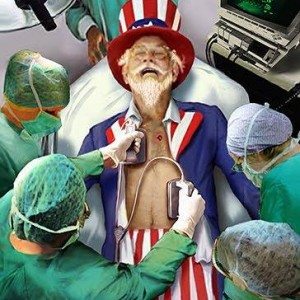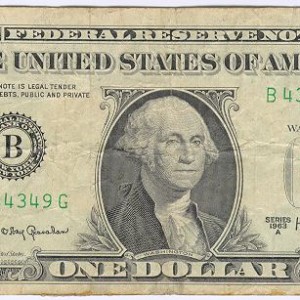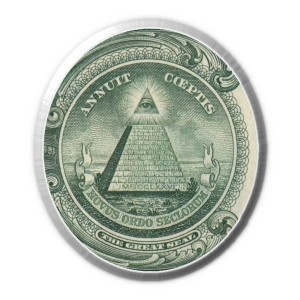 A lot of people are very upset about the rapidly increasing U.S. national debt these days and they are demanding a solution. What they don’t realize is that there simply is not a solution under the current U.S. financial system. It is now mathematically impossible for the U.S. government to pay off the U.S. national debt. You see, the truth is that the U.S. government now owes more dollars than actually exist. If the U.S. government went out today and took every single penny from every single American bank, business and taxpayer, they still would not be able to pay off the national debt. And if they did that, obviously American society would stop functioning because nobody would have any money to buy or sell anything.
A lot of people are very upset about the rapidly increasing U.S. national debt these days and they are demanding a solution. What they don’t realize is that there simply is not a solution under the current U.S. financial system. It is now mathematically impossible for the U.S. government to pay off the U.S. national debt. You see, the truth is that the U.S. government now owes more dollars than actually exist. If the U.S. government went out today and took every single penny from every single American bank, business and taxpayer, they still would not be able to pay off the national debt. And if they did that, obviously American society would stop functioning because nobody would have any money to buy or sell anything.
And the U.S. government would still be massively in debt.
So why doesn’t the U.S. government just fire up the printing presses and print a bunch of money to pay off the debt?
Well, for one very simple reason.
That is not the way our system works.
You see, for more dollars to enter the system, the U.S. government has to go into more debt.
The U.S. government does not issue U.S. currency – the Federal Reserve does.
The Federal Reserve is a private bank owned and operated for profit by a very powerful group of elite international bankers.
If you will pull a dollar bill out and take a look at it, you will notice that it says “Federal Reserve Note” at the top.
It belongs to the Federal Reserve.
The U.S. government cannot simply go out and create new money whenever it wants under our current system.
Instead, it must get it from the Federal Reserve.
So, when the U.S. government needs to borrow more money (which happens a lot these days) it goes over to the Federal Reserve and asks them for some more green pieces of paper called Federal Reserve Notes.
The Federal Reserve swaps these green pieces of paper for pink pieces of paper called U.S. Treasury bonds. The Federal Reserve either sells these U.S. Treasury bonds or they keep the bonds for themselves (which happens a lot these days).
So that is how the U.S. government gets more green pieces of paper called “U.S. dollars” to put into circulation. But by doing so, they get themselves into even more debt which they will owe even more interest on.
So every time the U.S. government does this, the national debt gets even bigger and the interest on that debt gets even bigger.
Are you starting to get the picture?
As you read this, the U.S. national debt is approximately 12 trillion dollars, although it is going up so rapidly that it is really hard to pin down an exact figure.
So how much money actually exists in the United States today?
Well, there are several ways to measure this.
The “M0” money supply is the total of all physical bills and currency, plus the money on hand in bank vaults and all of the deposits those banks have at reserve banks. As of mid-2009, the Federal Reserve said that this amount was about 908 billion dollars.
The “M1” money supply includes all of the currency in the “M0” money supply, along with all of the money held in checking accounts and other checkable accounts at banks, as well as all money contained in travelers’ checks. According to the Federal Reserve, this totaled approximately 1.7 trillion dollars in December 2009, but not all of this money actually “exists” as we will see in a moment.
The “M2” money supply includes everything in the “M1” money supply plus most other savings accounts, money market accounts, retail money market mutual funds, and small denomination time deposits (certificates of deposit of under $100,000). According to the Federal Reserve, this totaled approximately 8.5 trillion dollars in December 2009, but once again, not all of this money actually “exists” as we will see in a moment.
The “M3” money supply includes everything in the “M2” money supply plus all other CDs (large time deposits and institutional money market mutual fund balances), deposits of eurodollars and repurchase agreements. The Federal Reserve does not keep track of M3 anymore, but according to ShadowStats.com it is currently somewhere in the neighborhood of 14 trillion dollars. But again, not all of this “money” actually “exists” either.
So why doesn’t it exist?
It is because our financial system is based on something called fractional reserve banking.
When you go over to your local bank and deposit $100, they do not keep your $100 in the bank. Instead, they keep only a small fraction of your money there at the bank and they lend out the rest to someone else. Then, if that person deposits the money that was just borrowed at the same bank, that bank can loan out most of that money once again. In this way, the amount of “money” quickly gets multiplied. But in reality, only $100 actually exists. The system works because we do not all run down to the bank and demand all of our money at the same time.
According to the New York Federal Reserve Bank, fractional reserve banking can be explained this way….
“If the reserve requirement is 10%, for example, a bank that receives a $100 deposit may lend out $90 of that deposit. If the borrower then writes a check to someone who deposits the $90, the bank receiving that deposit can lend out $81. As the process continues, the banking system can expand the initial deposit of $100 into a maximum of $1,000 of money ($100+$90+81+$72.90+…=$1,000).”
So much of the “money” out there today is basically made up out of thin air.
In fact, most banks have no reserve requirements at all on savings deposits, CDs and certain kinds of money market accounts. Primarily, reserve requirements apply only to “transactions deposits” – essentially checking accounts.
The truth is that banks are freer today to dramatically “multiply” the amounts deposited with them than ever before. But all of this “multiplied” money is only on paper – it doesn’t actually exist.
The point is that the broadest measures of the money supply (M2 and M3) vastly overstate how much “real money” actually exists in the system.
So if the U.S. government went out today and demanded every single dollar from all banks, businesses and individuals in the United States it would not be able to collect 14 trillion dollars (M3) or even 8.5 trillion dollars (M2) because those amounts are based on fractional reserve banking.
So the bottom line is this….
#1) If all money owned by all American banks, businesses and individuals was gathered up today and sent to the U.S. government, there would not be enough to pay off the U.S. national debt.
#2) The only way to create more money is to go into even more debt which makes the problem even worse.
You see, this is what the whole Federal Reserve System was designed to do. It was designed to slowly drain the massive wealth of the American people and transfer it to the elite international bankers.
It is a game that is designed so that the U.S. government cannot win. As soon as they create more money by borrowing it, the U.S. government owes more than what was created because of interest.
If you owe more money than ever was created you can never pay it back.
That means perpetual debt for as long as the system exists.
It is a system designed to force the U.S. government into ever-increasing amounts of debt because there is no escape.
We could solve this problem by shutting down the Federal Reserve and restoring the power to issue U.S. currency to the U.S. Congress (which is what the U.S. Constitution calls for). But the politicians in Washington D.C. are not about to do that.
So unless you are willing to fundamentally change the current system, you might as well quit complaining about the U.S. national debt because it is now mathematically impossible to pay it off.
***UPDATE***
It has been suggested that the same dollar can be used to pay off debt over and over – this is theoretically true as long as the dollar remains in the system.
For example, if the U.S. government gives China a dollar to pay off a debt, there is a good chance that the U.S. government will be able to acquire that dollar again and use it to pay off another debt.
However, this is not true when debt is retired with the Federal Reserve. In that case, money is actually removed from the system. In fact, because of the “money multiplier”, when debt is retired with the Federal Reserve it can remove ten times that amount of money (and actually more, but let’s not get too technical) from the system.
You see, fractional reserve banking works both ways. When $100 is introduced into the system, it can theoretically create $1000 as the example in the article above demonstrates. However, when that $100 is removed, it can have the opposite impact.
And considering the fact that the Federal Reserve “purchased” the vast majority of new U.S. government debt last year, we have got a real mess on our hands.
Even if a way could be figured out how to pay off all the debt we owe to foreign nations (such as China, Japan, etc.) it would still be mathematically impossible to pay off the debt that we owe to the Federal Reserve which is exploding so fast that it is hard to even keep track of.
Of course we could repudiate that debt and shut down the Federal Reserve, but very few in Washington D.C. have any interest in doing that.
It has also been suggested that instead of just using dollars to pay off the U.S. national debt, we could use the assets of the U.S. government to pay it off.
That is rather extreme, but let us consider that for a moment.
That total value of all physical assets in the United States, both publicly and privately owned, is somewhere in the neighborhood of 45 to 50 trillion dollars. Of course the idea of the U.S. government “owning” every single asset of the American people is repugnant to our entire way of life, but let’s assume that for a moment.
According to the 2008 Financial Report of the United States Government, which is an official United States government report, the total liabilities of the United States government, including future social security and medicare payments that the U.S. government is already committed to pay out, now exceed 65 TRILLION dollars. This amount is more than the entire GDP of the whole world.
In fact, there are other authors who have written that the actual figure for the future liabilities of the U.S. government should be much higher, but let’s be conservative and go with 65 trillion for now.
So, if the U.S. government took control of all physical assets in the United States and sold them off, it could not even make enough money to pay for everything that the U.S. government is already on the hook for.
Ouch.
If you have not read the 2008 Financial Report of the United States Government, you really should. Actually the 2009 report should be available very soon if it isn’t already. If anyone knows if it is available, please let us know.
The truth is that the U.S. government is in much bigger financial trouble than we have been led to believe.
For example, according to the report (which remember is an official U.S. government report) the real U.S. budget deficit for 2008 was not 455 billion dollars. It was actually 5.1 trillion dollars.
So why the difference?
The CBO’s 455 billion figure is based on cash accounting, while the 5.1 trillion figure in the 2008 Financial Report of the United States Government is based on GAAP accounting. GAAP accounting is what is used by all the major firms on Wall Street and it is regarded as a much more accurate reflection of financial reality.
So needless to say, the United States is in a financial mess of unprecedented magnitude.
So what should we do? Does anyone have any suggestions?
***UPDATE 2***
We have received a lot of great comments on this article. Trying to understand the U.S. financial system (even after studying it for years) can be very difficult at times. In fact, it can almost seem like playing 3 dimensional chess.
Several readers have correctly pointed out that when the U.S. money supply is expanded by the Federal Reserve, the interest that is to be paid on that new debt is not created.
So where does the money to pay that interest come from? Well, eventually the money supply has to be expanded some more. But that creates even more debt.
That brings us to the next point.
Several readers have insisted that the Federal Reserve is not privately owned and that since it returns “most” of the profits it makes to the U.S. government that we should not be concerned about the debt owed to it.
The truth is that what you have with the Federal Reserve is layers of ownership. The following was originally posted on the Federal Reserve’s website….
“The twelve regional Federal Reserve Banks, which were established by Congress as the operating arms of the nation’s central banking system, are organized much like private corporations – possibly leading to some confusion about “ownership.” For example, the Reserve Banks issue shares of stock to member banks. However, owning Reserve Bank stock is quite different from owning stock in a private company. The Reserve Banks are not operated for profit, and ownership of a certain amount of stock is, by law, a condition of membership in the System. The stock may not be sold, traded, or pledged as security for a loan; dividends are, by law, 6 percent per year.”
So Federal Reserve “stock” is owned by member banks. So who owns the member banks? Well, when you sift through additional layers of ownership, you will ultimately find that people like the Rothschilds, the Rockefellers and the Queen of England have very large ownership interests in the big banks. But there are so many layers of ownership that they are able to disguise themselves well.
You see, these people are not stupid. They did not become the richest people in the world by being morons. It was the banking elite of the world who designed the Federal Reserve and it is the banking elite of the world who benefit the most from the Federal Reserve today. In the article above when we described the Federal Reserve as “a private bank owned and operated for profit by a very powerful group of elite international bankers” we may have been oversimplifying things a bit, but it is the essence of what is going on.
In an excellent article that she did on the Federal Reserve, Ellen Brown described a number of the ways that the Federal Reserve makes money for those who own it….
The interest on bonds acquired with its newly-issued Federal Reserve Notes pays the Fed’s operating expenses plus a guaranteed 6% return to its banker shareholders. A mere 6% a year may not be considered a profit in the world of Wall Street high finance, but most businesses that manage to cover all their expenses and give their shareholders a guaranteed 6% return are considered “for profit” corporations.
In addition to this guaranteed 6%, the banks will now be getting interest from the taxpayers on their “reserves.” The basic reserve requirement set by the Federal Reserve is 10%. The website of the Federal Reserve Bank of New York explains that as money is redeposited and relent throughout the banking system, this 10% held in “reserve” can be fanned into ten times that sum in loans; that is, $10,000 in reserves becomes $100,000 in loans. Federal Reserve Statistical Release H.8 puts the total “loans and leases in bank credit” as of September 24, 2008 at $7,049 billion. Ten percent of that is $700 billion. That means we the taxpayers will be paying interest to the banks on at least $700 billion annually – this so that the banks can retain the reserves to accumulate interest on ten times that sum in loans.
The banks earn these returns from the taxpayers for the privilege of having the banks’ interests protected by an all-powerful independent private central bank, even when those interests may be opposed to the taxpayers’ — for example, when the banks use their special status as private money creators to fund speculative derivative schemes that threaten to collapse the U.S. economy. Among other special benefits, banks and other financial institutions (but not other corporations) can borrow at the low Fed funds rate of about 2%. They can then turn around and put this money into 30-year Treasury bonds at 4.5%, earning an immediate 2.5% from the taxpayers, just by virtue of their position as favored banks. A long list of banks (but not other corporations) is also now protected from the short selling that can crash the price of other stocks.
The reality is that there are a lot of ways that the Federal Reserve is a money-making tool. Yes, they do return “some” of their profits to the U.S. government each year. But the Federal Reserve is NOT a government agency and it DOES make profits.
So just how much money is made over there? The truth is that we have to rely on what the Federal Reserve tells us, because they have never been subjected to a comprehensive audit by the U.S. government.
Ever.
Right now there is legislation going through Congress that would change that, and the Federal Reserve is fighting it tooth and nail. They are warning that such an audit could cause a financial disaster.
What are they so afraid of?
Are they afraid that we might get to peek inside and see what they have been up to all these years?
If you are a history buff, then you probably know that debates about a “central bank” go all the way back to the Founding Fathers.
The European banking elite have always been determined to control our currency, and that is exactly what is happening today.
Ever since the Federal Reserve was created, there have been members of the U.S. Congress that have been trying to warn the American people about the insidious nature of this institution.
Just check out what the Honorable Louis McFadden, Chairman of the House Banking and Currency Committee had to say all the way back in the 1930s….
“Some people think that the Federal Reserve Banks are United States Government institutions. They are private monopolies which prey upon the people of these United States for the benefit of themselves and their foreign customers; foreign and domestic speculators and swindlers; and rich and predatory money lenders.”
The Federal Reserve is not the solution and it never has been.
The Federal Reserve is the problem.
Any thoughts?
 Our last post, “It Is Now Mathematically Impossible To Pay Off The U.S. National Debt“, has created a ton of controversy and has generated over 100 comments so far. Much of the discussion has been about the role of the Federal Reserve and how they create money and debt. The truth is that the Federal Reserve system is a very complex subject that is very difficult to get a handle on. One thing that the Federal Reserve is NOT is a government agency. In fact, it is about as “federal” as Federal Express. It is a private central bank designed to make money for the people who created it. In fact, the Federal Reserve was the culmination of an effort by the international banking elite to force a permanent private central bank on the American people that began all the way back during the days of our Founding Fathers.
Our last post, “It Is Now Mathematically Impossible To Pay Off The U.S. National Debt“, has created a ton of controversy and has generated over 100 comments so far. Much of the discussion has been about the role of the Federal Reserve and how they create money and debt. The truth is that the Federal Reserve system is a very complex subject that is very difficult to get a handle on. One thing that the Federal Reserve is NOT is a government agency. In fact, it is about as “federal” as Federal Express. It is a private central bank designed to make money for the people who created it. In fact, the Federal Reserve was the culmination of an effort by the international banking elite to force a permanent private central bank on the American people that began all the way back during the days of our Founding Fathers. 
 No, the headline is not a misprint.
No, the headline is not a misprint. 